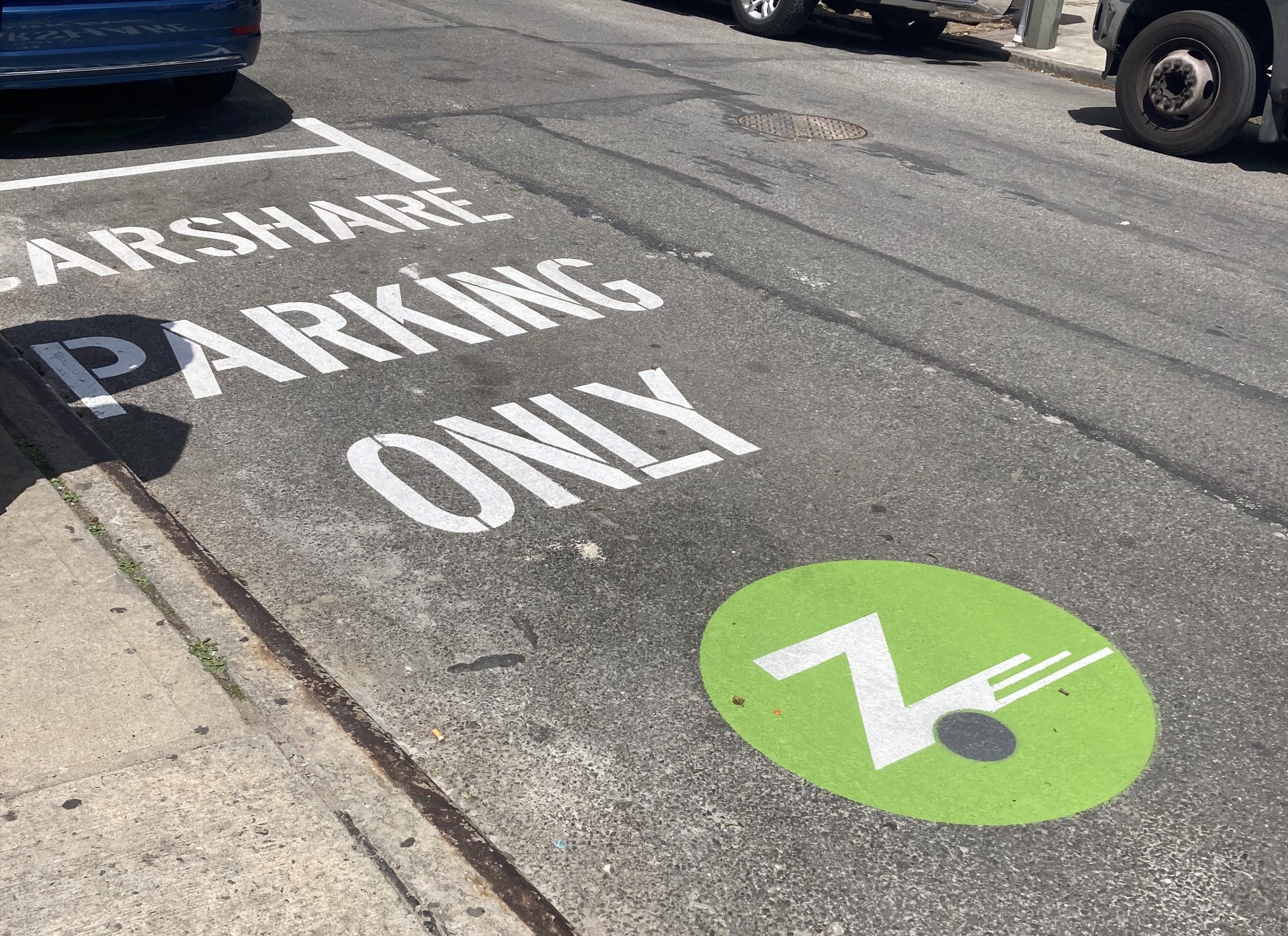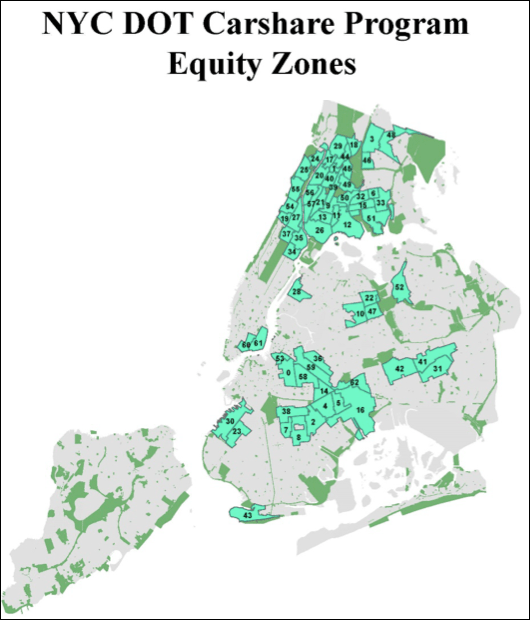City Sets Down Rules for a Permanent On-Street ‘Car-Share’ Program
12:01 AM EDT on July 12, 2022

A Zipcar spot in Brooklyn. Photo: Julianne Cuba
The city's fairly modest experiment in "car-share" is going citywide.
Following a three-year, 14-neighborhood pilot, the Department of Transportation last month laid out the ground rules for a permanent program to allow car rental companies to place vehicles in the street for hourly rental — an effort to reduce private car ownership and use of cars except when they are absolutely necessary.
The pilot did offer some encouraging news about so-called car-sharing in reducing vehicle miles traveled, new car purchase and the selling of existing cars. According to an analysis by the University of California Berkeley's Transportation Sustainability Research Center, VMTs dropped by 38.7 million miles annually — a less-than-one-percent declined from the tens billions of VMTs in the city every year, but definitely a start.
Each car-share member reported driving about 300 miles less when in the program. But only .61 percent of car-share members said they sold a car as a result of their membership (an estimated 783 cars). And a small number of participants claimed they did not buy a car as a result of the existence of car share (which the longhairs at Berkeley estimated prevented the deployment of 9,399 more cars).
The numbers are small, but there's reason for optimism.
"This relatively limited personal vehicle shedding effect is mainly due to the already low vehicle ownership rates in New York City and among the car-sharing population in general," the researchers wrote. "We found that less than 20 percent of members surveyed own a personal vehicle, at present. Thus, New York City car-sharing members do not have many personal vehicles to begin with that could be shed due to car sharing."
The Berkeley analysts used pre-pandemic mileage and vehicle use data provided by car-share companies, as well as its own three-pronged user survey: An initial survey polled New Yorkers who were already car-share members, a second survey was done quarterly with new car-share members, and a final survey gauged how car-share impacted members' transportation behavior and attitude towards car-share.
"Car-share is one more helpful way to reduce total car use and ownership and make more street space available," said Felicia Park-Rogers, the director of Regional Infrastructure Projects for Tri-State Transportation Campaign and the co-author of a 2019 study on the pilot. "It's better to have one car that's accessible to multiple users a week and in-use. It's also helpful to make available something that is economically prohibitive, but sometimes necessary, for low-income people. Car-share can do that."
The car-share rules that the city developed foist most of the responsibility for the system onto the car-share companies themselves. Companies that want dedicated parking spots are responsible for pitching the locations to the DOT, which will then evaluate them. Car-share companies also have to paint their own street markings to delineate which parking spots can only be used for the shared cars. Both policies were informed by findings in the city's final report on the car-share pilot.
DOT said that shifting the responsibility to car-share companies for finding parking spots is the biggest change from the three-year pilot — one that DOT changed because "it allows a citywide program to develop without creating undue strain on DOT from a staffing perspective; and it allows carshare companies to proactively identify locations that make the most sense for their business."
The DOT's pilot report noted that during the first year of the pilot, more than 20 percent of car-share trips ended with users finding blocked parking spaces when they tried to return their cars to on-street parking spots. To fix this, the DOT allowed the car-share companies to paint on-street parking spots in the second year of the pilot, a change that greatly helped, as "compliance dramatically improved after DOT allowed carshare companies to install and maintain pavement markings at their sites," with 10 percent or fewer trips ending with blocked parking spots in every neighborhood in the pilot.
The DOT didn't list how many on-street parking spots it is willing to make available to car-share companies going forward. When the city declared the program a success last year, it promised more than the 230 on-street parking spots and 55 municipal parking lot spots that were turned into dedicated car-share spots during the limited pilot. The agency is also offering companies either 10 percent or 10 total parking spots in 30 selected municipal parking lots, whichever number is smaller. Car-share companies will have the right to parking spots for one year at a time.
Like Citi Bike, which reimburses the New York for the parking spots that bike share docks replace, companies that want dedicated spots will have to pay $485 for two on-street spots or whatever the annual rate is at an eligible municipal parking lots, a price that ranges from $2,400 per year to $11,500 per year, a discount over what members of the public pay for spots.

The city is also requiring any company that participates in the car-share program to put at least 20 percent of its dedicated parking spots in neighborhoods identified in the Streets Master Plan as historically underserved — a requirement that should broaden the reach of the car-share program, which was clustered in northwest Brooklyn and northern Manhattan, and disconnected neighborhoods in Queens and the Bronx during the pilot. The new equity requirement will require dedicated parking spots in basically what the DOT calls Tier 1 Priority Investment Areas: most of the Bronx, big swathes of central Brooklyn or central and southeastern Queens.
The equity placement requirements will seek to build on the pilot data showing that more low-income and Black and Latino New Yorkers signed up for carshare as the pilot went on. The TSRC found that respondents with household incomes under $50,000 rose from 17 percent in 2018 in the initial survey before car-share started to 24 percent in the third survey. Additionally, the number of Black respondents went from 8.5 percent to 12.9 percent and the number of Latino respondents from 8.2 percent to 16.8 percent between the first and third surveys. (Rates to rent a car by the hour differ by company; Zipcar offered a $9 monthly "membership," which entitled drivers to rent a Honda Civic for about $12 per hour or $100 for the day with gas included.)
The DOT also declined to answer a series of questions on which companies have applied to be part of the permanent program so far, how the program would be measured as a success or a failure, whether it would publish a map of car-share parking spots in the future or how many on-street parking spots it's going to make available in the program, with a spokesperson saying that it will figure out how to make program data available in the future.
I suspect that car-sharing systems like Car2Go could be a big part of reducing the overall number of cars on the street. This could free up more curbside for dedicated bus and bike lanes and start to create a virtuous cycle where NYCers don't feel so tied to car ownership.
— Aaron Naparstek (@Naparstek) June 25, 2019
"DOT will be collecting data on system use, and is evaluating the best way to make this information publicly available," said DOT spokesman Tomas Garita.
It's unclear how many companies will participate in the permanent program now that applications to participate in it are open, or what the total size of the permanent program will be. When the pilot began, Zipcar, Enterprise and Car2Go all participated, with a total of 2,526 car-share vehicles available between October 2018 and September 2019. But Car2Go went out of business during the pilot, and Enterprise indefinitely suspended its car-share operations during the pandemic. Zipcar put out a statement celebrating the success of the pilot program in April 2021, but the company did not respond to Streetsblog when asked if it would be returning to the city for the permanent program. Enterprise Car Share only lists three locations in the United States where it is participating in car share, and last we checked, Grinnell College, Washington University and Princeton University are nowhere near New York City.
Dave Colon is a reporter from Long Beach, a barrier island off of the coast of Long Island that you can bike to from the city. It’s a real nice ride. He’s previously been the editor of Brokelyn, a reporter at Gothamist, a freelance reporter and delivered freshly baked bread by bike. Dave is on Twitter as @davecolon. Email Dave Colon at dcolon@streetsblog.org
Stay in touch
Sign up for our free newsletter
More from Streetsblog New York City
Stockholm Leader’s Message to NYC: ‘Congestion Pricing Just Works’
"In Stockholm, people really thought that congestion pricing would be the end of the world, the city will come to a standstill, no one would be able to get to work anymore and all the theaters and shops would just go bankrupt. None of that happened."
Friday’s Headlines: Trump Trial Trumps Safety Edition
Is anyone going to bother to fix the dangerous mess on the streets and plazas around the Trump trial? Plus more news.
Adams Offers Bare Minimum to Seize Congestion Pricing’s ‘Space Dividend’ Opportunity
The mayor's list of projects supposedly meant to harness congestion pricing's expected reduction in traffic is mostly old news, according to critics.
OPINION: Congestion Pricing Will Help My Family Get Around As We Navigate Cancer Treatment
My partner was recently diagnosed with cancer. Congestion pricing will make getting her to treatment faster and easier.




